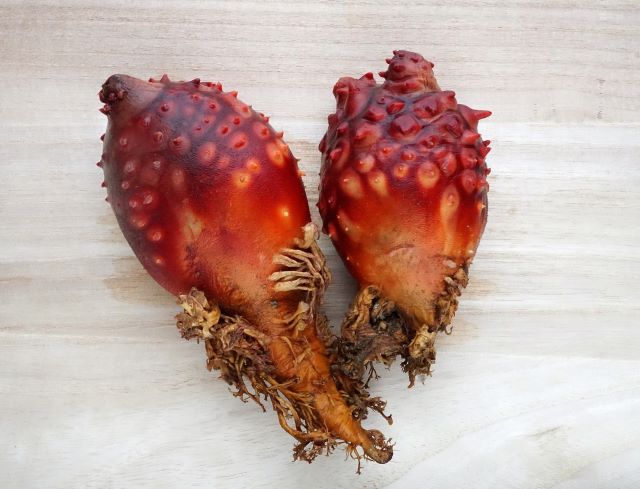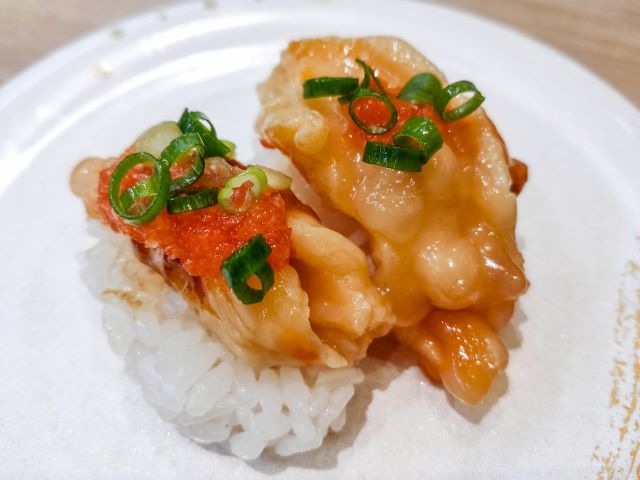
What is Sea squirt (Hoya)?
Sea squirt (Its Japanese name is Hoya) is thought to be a specialty of the Tohoku region, but it is distributed from Hokkaido to Honshu, Shikoku, and Kyushu, as well as from the Korean Peninsula to the Shandong Peninsula of mainland China.
It has red, hard skin and protruding warts, the tops of which have entry and exit holes, and lives attached to rocks and other objects on the seafloor.
The sea squirt is nicknamed the pineapple of the sea because of its resemblance to a pineapple, which is not clear whether it is an animal or a plant. It is a close relative of vertebrates, although it is not at all imaginable. Its size is about 20 cm.
The two main species of Hoya (海鞘、老海鼠) consumed in Japan are Ma-hoya or Maboya (Halocynthia roretzi (Drasche, 1884)) and Aka-hoya or Akaboya (Halocynthia aurantium aurantium (Pallas, 1787)). Maboya has numerous conical protrusions on its shell surface and reddish-orange flesh. In contrast, the red-fleshed “Akaboya” is characterized by a smooth, untextured shell surface. Miyagi Prefecture accounts for about 80% of the nation’s production, while Aka-hoya is mostly produced in Hokkaido.
Sea squirt flesh contains vitamin E, which has antioxidant properties. By suppressing the oxidation of unsaturated fatty acids in the body, it is thought to help prevent lifestyle-related diseases such as arteriosclerosis and myocardial infarction. Furthermore, per 100g of sea squirt, it contains approximately 130mg of EPA and 55mg of DHA, making it rich in omega-3 fatty acids essential for maintaining cardiovascular health. It also contains minerals such as phosphorus (approx. 55mg), iron (approx. 5.7mg), zinc (approx. 5.3mg), and B vitamins.
What does Sea squirt (Hoya) nigiri sushi taste like?

Its edible parts are the muscles and internal organs, which are removed by peeling the skin. Hoya’s gonads get fatter in the fall and its muscles become leaner. Then, after May, the meat gets fatter and has eight times more glycogen than in winter, making it tastier and sweeter. If the body color of Ma-hoya is pineapple color, Aka-hoya is the color of a persimmon seed that has fully ripened to bright red.
Sea squirt takes in a lot of seawater, so it has a strong smell of the sea anyway. It also has a unique umami and bitter taste because it is rich in amino acids such as glycine, alanine, Taurine, proline, and glutamic acid.
Ma-hoya is generally considered to have a stronger flavor, while Aka-hoya is relatively mild. After a few hours of fishing, a kind of gasoline smell is produced, giving the sea squirt its distinctive aroma. For this reason, it tends to be avoided by first-timers, but many people become addicted to it once they have tasted it. It is also a dish that makes sake go down a treat.
The fresh sea squirt meat is so elastic that it bounces back. The fish is then cut into small pieces with a decorative knife so that it is soft but still crisp. For condiments, we recommend using asatsuki chives, grated daikon and chili, and ponzu (Japanese citrus juice) soy sauce. Ma-hoya is not for everyone, but it can be enjoyed as an unusual sushi topping.
To enjoy the aroma of the sea, eat it raw with wasabi soy sauce or vinegared food. It goes well with cucumber as an accompaniment. Besides, it can be simmered, grilled with miso, deep-fried, or salted.
[sc_apply url=”https://sushiuniversity.jp/apply/”]
We hope this information will be helpful.

Revision date: December 31, 2025
Share this article
I was in Hanamaki (Iwate prefecture) and my love of sushi was apparent to my Japanese hosts. They asked me if I wanted to try something unusual, and I said Ok. When the chef showed us the Hoya, I asked if it was animal or vegetable. He shrugged. I ate it. Not my thing, but not bad. Thereafter, when we walked into a restaurant the hostess would discreetly ask if a Japanese menu would be Ok for me. My host told them “He ate Hoya!” and everyone would cheer.